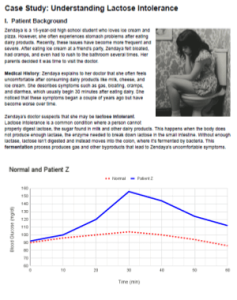
I made this case study for freshman level biology to complement Ch 2: The Chemistry of Life. Students review the structure of atoms and molecules, then learn about biomolecules and enzymes. This case study explores the human side of enzymes and proteins. Specifically looking at how humans have a special enzyme, lactase, to digest milk sugar, or lactose. Many people do not produce this enzyme after childhood and develop a condition commonly known as “lactose intolerance.”
In this case study, Zendaya is a 15 year old high school student that has stomach issues after ingesting ice cream and other dairy products. These symptoms usually occur within 30 minutes of eating those types of foods. At the doctor’s office, they test her for lactose intolerance.
Finally, students reading the story will answer questions about her symptoms, and analyze the lactose intolerance test. The graph shows that Zendaya’s glucose levels do not change after drinking a liquid containing lactose. In other people, glucose levels will rise as the enzymes break down the lactose in glucose and galactose.
The Biochemistry of Lactose
In the second part of the activity, students examine a graph showing the “lock and key model” of enzyme interaction. They label the enzyme, substrate, and products. Then they examine a graphic of the digestive system showing the lactose is processed in the small intestine. For those without the enzyme, the lactose remains intact until it gets to the large intestine. There, microbes in the large intestine break down the sugar in a process called fermentation. This process releases gas which results in abdominal pain, and bloating.
Finally, students explore a simple treatment for being lactose intolerant. A commercially available product, Lactaid, can be taken before eating dairy products. This drug contains the enzyme to break down lactose, thus eliminating the need for the body’s own enzymes to do that job.
Related Resources
Analyzing Graphics: Enzymes – Identify reactants and products, analyze reaction rate graphs
Enzymes and Substrates Coloring – includes information on how enzymes work and coloring instructions
Enzyme Lab – explore how hydrogen peroxide breaks down in living tissues into water and oxygen bubbles
Observe Catalase Activity in Yeast – create sodium alginate spheres to observe how catalase breaks down hydrogen peroxide

